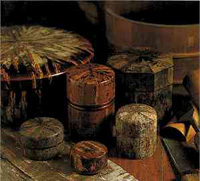Kaba Crafts
This handcraft using the bark of mountain cherry is an art to be seen only in this area of Japan.
It is said that in the Tenmei Era (1781-89), a samurai of Kakunodate called Hikoroku Fujimura learned the art, which was then a craft of folk tradition in the mountains of Akita, and taught other samurais. This is said to be the origin of Kakunodate's Kaba Craft.

Developed in a town of history, and utilizing traditional techniques, the Kaba Craft was designated Traditional Craft by the Ministry of International Trade and Industry in 1976. It is widely loved as a true craft that brings pleasantness into everyday life. In 1978, the Kaba Craft Heritage Center was established to further promote and develop Kaba Craft.
The heritage center exhibits reference material on Kaba Craft, and also shows demonstrations of the actual craft.
Kinds of Kaba Craft
(Kata Mono)
Also called Shikomi Mono. First you make the core along the wooden
frame with kyogi (wood shavings), and then paste the Kaba on the wooden
frame, gradually forming a cylinder. Main products of this type were,
of old, Tobacco pouches and Inro (small accessorial medicinecontainers),
but today the process can be seen in making tea containers.
(Kiji Mono)
These use kiji (the wood's texture) as the base texture, and are mostly box-shaped. Letter boxes, writing boxes, tables and tea cabinets are some examples. It sometimes requires the delicate art of decoration with patterns.
(Tatami Mono)
Tatami (or tatamu, to fold) is referring to the process of shaving the mountain cherry bark to very fine sheets and piling them to be several centimeters thick. It was a technique for pouches and netsuke ornaments for the inro. Using the polished sides showing the layers as an accent, the techinque is used for obijime (band for the obi sash), tie pins, pendants and other accessory.
| Contact Info | Semboku City Tourism Information Center "Kakunodate Ekimae-Gura": 0187-54-2700 |
|---|---|
| Dealer | Demonstration sales are conducted in several places, including the heritage center in the Bukeyashiki. |
- Access
- Sightseeing Spots
- Choose from areas
- Hachimantai/Tamagawa
- Nyutou
- Tazawako Plateau/Mizusawa/Komagatake
- Tazawako
- Dakigaeri/Jindai/Shiraiwa
- Nishiki
- Kakunodate
- Seasonal Recomendations
- Lists by Season
- Campgrounds
- Products
- Other
